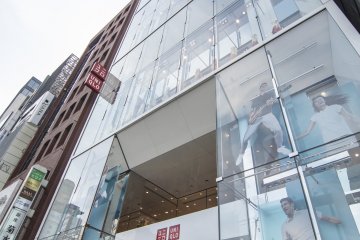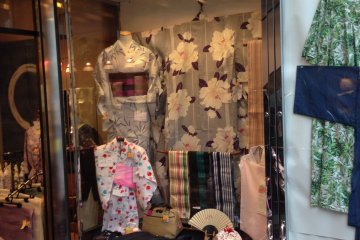Do you have any plans to visit Japanese firework events or other local summer festivals? It has become kind of trendy again to wear a yukata, a light cotton kimono, at these kinds of events, especially among the young generation. So this is a great opportunity for you to wear a kimono, too. Why not try it?
Why in Ginza?
Of course there are a lot of kimono shops, but if you hope to get some traditional and beautiful yukata or kimono, looking for some in Ginza, Tokyo, is great fun and an exciting experience.
As you know Ginza is full of many high-class specialty shops, which are proud of their own history and tradition. It is here, where famous people from traditional stage arts like Noh, Kabuki and traditional dance buy their kimono, so does the Imperial family. Also, Ginza is closed to Tokyo’s biggest Geisha district Shinbashi, where kimono still holds a strong tradition.
However, not only for such gorgeous customers, there are many other people who need to wear kimono for work. You might notice that at many Japanese restaurants in Ginza you are served by women wearing kimono, traditionally called "nakai". It is natural that they need washable and firm kimono when working hard. Good looking but practical (and hopefully at a reasonable cost) kimonos are necessary for these people.
So, if you hope to find some reasonable and attractive yukata or kimono, I recommend you head to Erikiku Ginza Minami (ゑり菊 銀座南店).
They sell many attractive ready-made yukata or kimono under ¥10,000. However, you can also get a tailor-made kimono of course. You will then need to pay for the fabric plus around ¥10,000-20,000 for a yukata and ¥20,000-30,000 for a kimono.
Kimono sizes often depend on each maker, so please ask the shop assistant if you find it difficult which size you choose. This is a rough guide for women kimono:
S size: height 150cm, bust 83cm, hip 88cm M size: 155cm, 86cm, 91cm L size: 160cm, 91cm, 96 cm LL size: 165cm, 98 cm, 103 cm
What else do you need when you want to wear a yukata? Yukata made of thin cotton can be quite transparent, so some proper underwear is highly recommended. Furthermore, in Japan’s hot and humid climate, without underwear your yukata would stick to your skin and make walking difficult.
Traditionally you would also need a pair of geta sandals; however, it is okay to wear other suitable sandals in order to add a casual or modern taste. Young Japanese often enjoy combinations like that. Don’t forget the "obi", a belt especially for yukata.
The kimono shop Erigiku usually has a special sale until the end of August, when they offer a discounted obi belt and/or geta sandals when you buy a yukata. However, these sales depend on their stock; hurry up if you want to get the chance!
How to wear a yukata?
You can find many videos about how to wear a yukata on the Internet, or there are some specialized magazines for kimono lovers. It is not so difficult; apart from tying your obi belt maybe. However, there is an easy way too. Get a ready-made obi, which is already tied and you just need to adjust it to your waist. Otherwise, kindly ask the shop assistant to show you. Some shops even offer courses how to dress properly; this could be fun, too!
You want to get your hair done as well? A lot of hair salons offer special prices for putting your hair up during the yukata season.
In case you experience any problems with your yukata or the obi belt during the event, don’t hesitate to ask someone else around you wearing yukata; especially middle-aged ladies have often learned how to properly wear a kimono and they are very passionate about it.
Yukata is loved by Japanese for its lightness and casual touch. They are more comfortable and have bolder designs than other seasons’ kimonos. Seeing people in yukata brings a special summer feeling to everyone. So if you wear a yukata too, this will be a charming sight for other people around you too!









